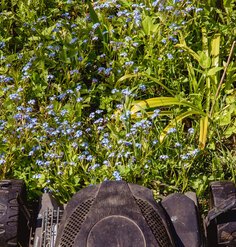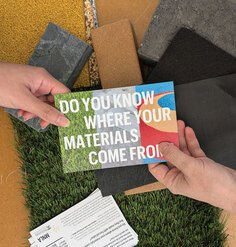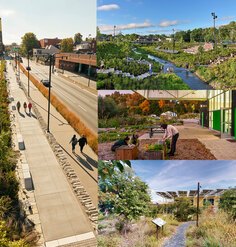From the Field: Emergent Ecologies, Alternative Aesthetics, and Public Opinions
By Paul Littleton, MLA Candidate and M. Elen Deming, Ph.D., Professor, Department of Landscape Architecture, University of Illinois at Urbana-Champaign
The three projects we examined this summer through LAF’s Case Study Investigation (CSI)program — Carmel Clay Central Park (Carmel, Indiana); Lowland Park at Milliken State Park (Detroit, MI) and The City of Ann Arbor Municipal Center (Ann Arbor, MI) — shared some common characteristics. They were all public landscapes; at different scales and contexts each created a new kind of community center; each provided ecosystem services for stormwater management; each project saved or “paid back” public resources. Also, each project adopted an ecological aesthetic that recalibrated or redefined what many users expect from public landscapes.
In a sense, each of these projects tries to teach visitors about hydrological processes by laying them bare to view. Trouble is, not everyone understands what they see. Behind the performance benefits quantified for our projects we sense there may be other social impacts to be measured. We enjoyed enthusiasm for these places by designers and clients; we also encountered a level of puzzlement and ambivalence toward public open spaces that adopt a new attitude towards nature.
A case in point is the highly innovative design at the Ann Arbor Municipal Center (AAMC). Our methodology for measuring social benefits involved a short survey asking respondents to identify their familiarity with the place (employees or visitors, level of use of various amenities, etc.), how they thought the project reflected on the city of Ann Arbor, and whether they would consider similar stormwater management techniques for their home landscapes or in other projects. The City of Ann Arbor assisted our survey process by announcing it through a public press release and installing posters with a QR (quick response) code throughout the AAMC.
Response level and survey depth was spectacular — 123 responses in just three weeks, more than 100 surveys fully completed, with 35 thoughtful individuals adding more comments after the survey was done. Ann Arbor obviously cares deeply about its public open space. Because public opinion was so sharply divided over the merits of the project as a whole, we wanted to share a few representative responses.
Supporters of the project said: “The designers did a good job”; “It’s great to be able to demonstrate these features to private developers when we’re trying to encourage them to consider low-impact development techniques”; “Parts of the center offer good examples to show clients considering such features in their own buildings.”
Naysayers wrote: “If city hall is trying to lead by example, they are failing. They come across as being “smarter” vs. inclusive… They force stuff vs. letting it develop out of a genuine public want”; “these features do not improve my experience of the building and are not presented in a way that improves environmental consciousness… [T]he overall lay out removes public space in front of and on the roof of the building from public use… [as if] the city government doesn’t actually want the public to be able to gather near or around the building.”
Some grasped issues of landscape performance: “[T]he green roof is creating habitat for bees, birds and other insects“; “I watched the big rain storm a week or so ago (2.5 inches in less than an hour); when I got to City Hall for a meeting, over 8 inches of rain water remained in the rain garden. When I left that meeting, 2 hours later, all the water was gone. That’s what rain gardens are supposed to do. I was and am impressed.”
Others missed the point: “[I]t rains so much here, I don’t think many people are very concerned about water. Maybe if we lived in a desert we’d celebrate collecting water more, but really, the whole rain garden idea seems like it will be a smelly, swampy mess and a breeding ground for West Nile virus.”
Finally, many offered the City constructive advice: “It is my perception that near to, if not all, of the hostility towards the municipal center’s rain gardens and its water feature are due to poor program execution…. I advise a clear avenue for public input and comment in the design of such installations”; “Downtowns should be for people, first. To the degree that great spaces can be built around and/or incorporate art, music, or eco-friendly educational opportunities and infrastructure, all the better.”
The big lesson from the survey is a simple correlation: people who spent a greater amount of time on the site — employees — gave more positive and insightful responses to our questions than casual visitors did. Landscape architects often try to lead innovation toward emerging value systems like sustainability, transparency, and inclusiveness. It is good to remember that building awareness (and changing taste) takes time, patience, and many, many opportunities for public dialogue.
Research Fellow Elen Deming and student Research Assistant Paul Littleton are participating in LAF’s 2013 Case Study Investigation (CSI) program and working to evaluate the environmental, economic and social performance of three landscape projects in Michigan and Indiana. Any opinions expressed in this article belong solely to the author. Their inclusion in this article does not reflect endorsement by LAF.











